A surprising fact: all the existing colors of cats, all shades and tones - the result of the work of two types of pigment, pheomelanin and eumelanin. The first determines the entire spectrum of red colors, the second - black, from anthracite hues to delicate cream halftones. How does the two pigments produce such a variety of shades and patterns?
Even at the stage of embryonic development, pigment cells are formed in the neural tube, which are not yet capable of producing a pigment. After a while they change, taking the form of a spindle - begins a gradual migration to the hair follicles. Genetics of cats' colors - science is complex and at times unpredictable, because on the way to hair pouches and even after the introduction of pigment cells, multiple changes occur to them. Under the influence of genes inherited from parents, pigment cells are distributed in one way or another, change shape or become unable to produce a pigment.
To understand what cat color means to a geneticist, imagine any culinary masterpiece. A restaurant visitor will try a delicacy and admire the general taste. But if the taster turns out to be a cook, he will put the dish into its mind in order to understand how, when the ingredients are mixed, the desired taste will turn out. Similarly, a geneticist - seeing a cat, he sees not the color of six, but the supposed set of genes. After all, only in this case, it is possible to calculate the color of cats: without knowing the genotype of the parents, it is impossible to predict how the offspring will turn out.
Color of the "black" group
For normal formation of black pigment the gene B (black) answers. Under the influence of gene b, the pigment is oxidized - a brown color is obtained. But B suppresses the action b (the capital letter is the dominant, the lowercase is the recessive gene). Thus, the cats BB and Bb look equally black, and if the kitten has inherited from the parents two bb, it will be brown (saturated chocolate) color. Kittens inherit one chromosome from each parent. Therefore, when crossing individuals BB plus Bb "chocolate" is not born - nowhere to take two bb.
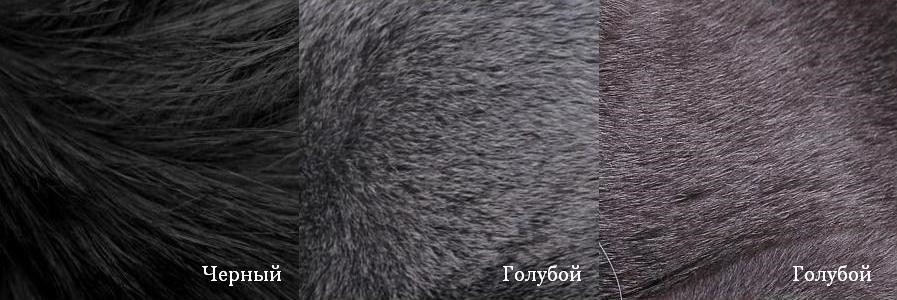
Gene bl oxidizes pigment even more than gene b - a light warm shade of brown, called "cinnamon", is obtained. But b and B suppress bl, so the kitten must get bl from both parents, otherwise it will not be cinnamon.
When the genetic codes of cat colors include D (d), it is a matter of enhancing or brightening the pigment. Gene D makes the color saturated, allows the pigment to be densely distributed in the wool: cat B_DD - black. Gene d "muffles" colors, forming less bright calm shades: the cat B_dd - gray. But the kitten B_Dd will be black, because gene D is dominant to d, it blocks it.
Lower underlining means that it does not matter which gene is in its place, dominant or recessive - the color in both cases will be the same.
Kittens will turn purple if they inherit from their parents two "weak" genes: bl (chocolate) and dd (clarification). Thus, purple is a clarified chocolate.

White color
It's about true white color (not albinism and not white spotting). White is not an independent color, but a complete absence of pigment. Only one gene blocks the pigment cells, designated by the letter W. If in the genotype of the kitten we see ww (two recessive genes) - the baby is colored. If we see W, even if the color codes of cats consist of a lot of letter designations, before us are solid snow beauties. For example, BBOoSsddWw is a white cat.
But genetically, such cats can carry both spotting, and different colors, and drawing. All this diversity will manifest in their offspring, provided that the kittens do not inherit W. Looking at the white cat it is impossible to guess that it carries genetically, so when crossing they look into the pedigrees of the ancestors (look at the parents of the white cat and assume which bearer of which genes it may be ). At the same time, one of the parents of the white cat is also necessarily white (otherwise, where would W come from?), So they look even further - they look at "grandfathers" and "grandmothers".
There is a common coding of the colors of cats, which facilitates identification. For example, "walking" on the sites of nurseries, it is sometimes difficult to determine the color from photos, since a flash or weak light distorts the shades, can hide strips, etc. If there are letters and numbers next to the photo or there is a link to the pedigree, the cat color chart, which is given at the end of the article, will help.
Colors of the "red" group
For the "red" colors, the O gene answers, from a bright almost brick shade to barely noticeable cream tones. Gen O is only in the female chromosome, so the cat (XY) can carry only O or only O, but in the genotype of the cat (XX) there can be different combinations (OO, oo or Oo). The lower-order o-recessive gene, suppressed by O. Moreover, O is dominant with respect to B, i.e. suppresses black colors. Thus, the cat that received the gene O from the mother will necessarily be red (of course, if there is no W gene suppressing the color). A cat can be born and red, and this: BBOoDD (the first O suppresses B, the recessive o from the second B "does not cope" - we get a tortoiseshell color).

If the DD are adjacent to the OD, the orange colors of cats will be sunny, bright. If dd - wool gets a gentle cream tone, as dd lightens not only black (B), but also the red color.
Colors with white spots
On any colored spot, white patches may appear. Sometimes their presence is necessary, and in other cases is a serious drawback or even a disqualifying defect (see the standard for a specific breed).
So, the white areas appear due to the action of the dominant gene of white spot S. At the same time, the white area is larger if the kitty is homozygous, that is, SS. Heterozygous individuals Ss, as a rule, are more colored. At ss, white specks are absent altogether (not counting the small white area under the chin that appears under the action of other, "secondary" genes).
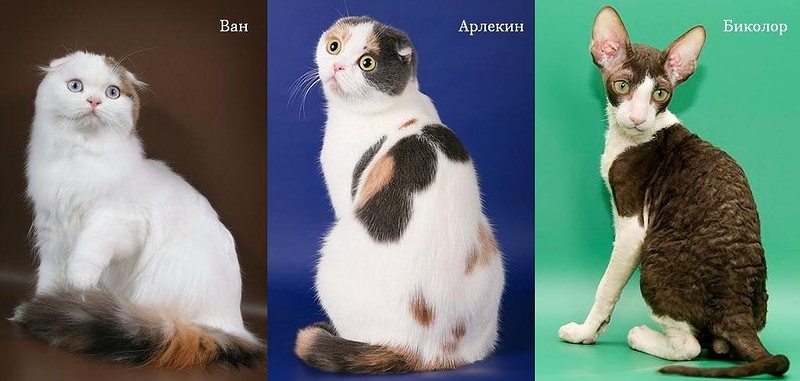
There are many modifier genes that affect the location, shape and amount of white spots. Unfortunately, the genetics of cats' colors does not yet give an unambiguous answer to the question of which genes and how they affect the degree of spotting. For this reason, it is quite difficult to work with colors such as van, harlequin and bicolor. It is not easier for those who aspire to get perfect "socks" or even a white "mask" - even two magnificent parents have kittens with "tight" socks or "masks" that have left behind the desired boundaries.
Siamese colors
For pigment cells to function, a copper-containing tyrosinase enzyme is required. If the cat is the bearer of the dominant C, the fur will be colored evenly. But there are a number of recessive genes that limit the function of tyrosinase. In this case, the enzyme "allows" coloration only in areas where the body temperature is lowered. And where the body temperature is higher, a limited amount of pigment is produced - lighter parts of the coat. A common classification of cat colors with darkened ears, muzzles, paws and tails is as follows:
siamese color (cscs) - dark points, very light body, blue eyes;
burmese color (cbcb) - points are less noticeable, the contrast between the body and the points is less pronounced, the eyes are golden;
tonkinsky color (cscb) - as can be seen from the code, this is an intermediate variant between Burmese and Siamese, the eyes are turquoise.
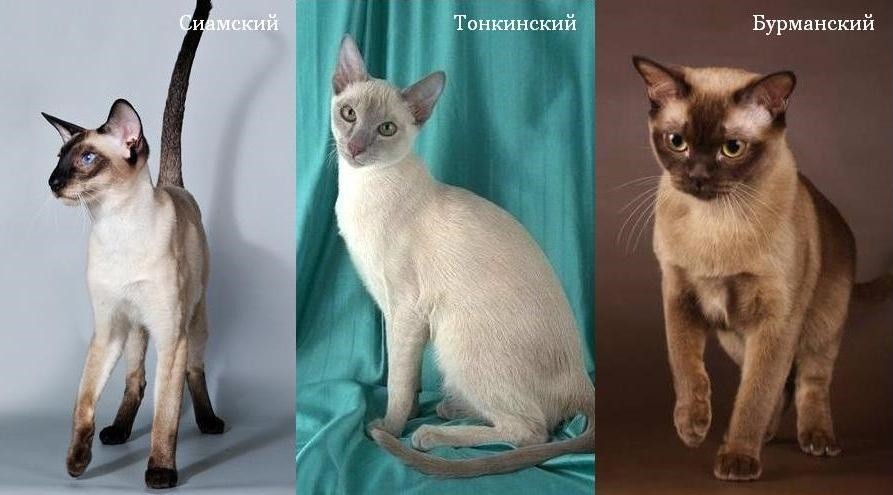
Since the "point" color is manifested through the action of two recessive genes, both parents must necessarily carry at least one gene of the "c" series. That is, from a cat or cat, in the genotype of which there is no cs or cb, a kitten of point color will never be born.
Figured
Any color can be patterned. The shape of the pattern is determined by a series of T (tabby) genes. And such genes are in the genotype of absolutely every cat. But, as you know, not every cat is striped or spotted. It's all about another gene - A (agouti). This gene then "turns on", then "turns off" as the hair grows, coloring the hair with transverse rings alternating with dark and light tones. Decoding of cats' colors begins with a search in the genotype of two genes - T and A. If there is at least one A, the cat will be patterned. If there are two aa (homozygous recessive set) in the genotype, the fur coat will be painted evenly, since without drawing (staining the hair with strips) drawing is impossible.
The gene of "red" colors O suppresses the action of the allele aa, so the red coat is always more or less striped. Sometimes the pattern is almost invisible, but it is - take a look at the muzzle and the lower parts of the paws of an orange or cream cat.
So, what does the color of a tabby cat mean? The answer is obvious: the cat is the carrier of the dominant agouti gene (A). Now look at the tabby (T) gene:
gene T (other designation Tm) forms strips, the so-called "brindle" color;
gene Tb forms wide ornate lines, marble color;
the Ta gene does not form a pattern, allowing you to enjoy the "pure" agouti, when the fur coat overflows due to the zone color of each wool.

Ta (abyssinian color) is dominant with respect to T (strips), and T dominates over Tb (marble). But there are still specks! But with them it is more difficult: whether there is a specific gene that allows spotting to appear, or spots - the result of the work of a group of modifier genes that "tear" stripes (the latter is more probable).
Shaded
Any color, including tabby, can be silvery or shaded. Visually, it looks like this: some part of the tip of the wool is colored, and the basal area is whitened or much lighter than the tip. That is, the colored hair first grows, then the inhibitor I inhibits the gene, which either completely stops the pigment production (then the rest of the hair grows white), or slows the pigment production (then the basal part is weakly but colored). Smoky colors are the work of an inhibitor in the genotype aa (ie, not agouti, solid color). Silvery colors are gene I in genotype A, i.e. figured cat.
The difficulty is that the inheritance of color in smoke and silver cat cats is often unpredictable. That is, to get a chinchilla (the very tip is painted) or smoke (white roots only) is easy, but to achieve the ideal length of the painted area and the perfectly flat bleached base is almost like taking part in the lottery. It is not completely clear why Gene I is starting to work now, and not later. And it is not clear how many and which modifier genes are involved in this process.

Promised table of cats colors according to the WCF system. Some inconsistencies with the notations accepted in other systems are possible, but in general the coding is the same. Coat colors:
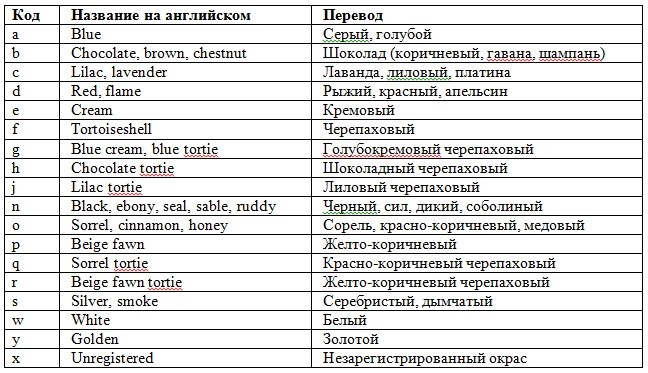
Color "with white", drawing, the presence of points:
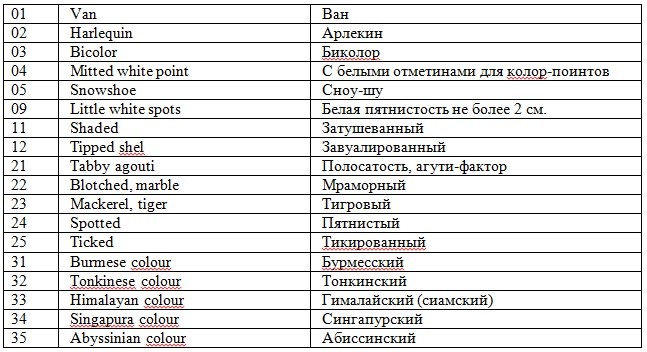
Color of cats and genetics of cat colors for teapots.
Cats are different from many other animals, even belonging to the same cat family, with an incredible variety of colors. For example, all lions, except for albinos, are approximately the same in color, cheetahs, pumas and jaguars within the same species are also quite the same. Not to mention other animals such as zebras, giraffes and rhinoceroses. Cats - however, everyone saw it himself - show an infinite variety in color variations. In many respects, the diversity of the colors of modern cats is due to the variety of breeds and the careful selection that breeders are carrying out for the destruction of more and more rare cats colors. However, even without selection, cats are capable of much. For the color of cats, not so many genes are responsible, but in a variety of combinations and under the influence of different alleles - clarification, the type of pattern, etc., they create an infinite number and do not cease to fascinate breeders seeking unusual colors or ordinary lovers of cats who have found their favorite or favorite in the attic or basement.
Among the main genes responsible for the color of cats, there are genes responsible for solid color or color in combination with white, the number of variations in the distribution of which is infinite, the genes of black and red (red) color, as well as their clarifiers giving clarified black - blue (usually called gray) and clarified red (cream). Also there are genes that paint a cat's fur with various patterns - stripes, spots or more fanciful curls called marbles. These genes color the cat's wool in different colors throughout its length. Different combinations of this coloration also give different colors. The gene, which suppresses the manifestations of all these colors, makes the cat wholly white. The gene of acromelanic color is light with dark markings and blue eyes. And if you imagine that these genes basically work in a group, then it's easy to guess that the number of colors is limited only by the imagination of nature (and the breeder), which, as is known, is inexhaustible. Color of cats are more diverse than cats, because the color of the cat can combine the actions of genes of black and red color, which is impossible in cats, since the red color gene can be associated only with the X-chromosome. The chromosome set of the cat is XY, the cat is XX. Accordingly, the cat, having only one X chromosome, can be either red or black (or clarified red or clarified black), the cat can carry a combination of these two genes in the usual or diluted (clarified) form. As a result of the joint action of the genes of black and red, cats with bright spots of black and red (red) color appear, sometimes in combination with white, with a pattern, with clarification, with acromelanic coloring and other unbelievable colors. Very rarely born cats that have in color red and black. This is the result of a genetic mutation (the genetic code of such a cat is XXY, not XY), so these cats are often sterile (sterile).
So, how to determine the color of a cat, who lives in your house? A cat bought in a kennel with documents has a pedigree in which its color is registered, as well as the colors of its parents and ancestors to the fourth tribe. And if the cat is picked up on the street, and all of its documents - it's a mustache, paws and tail? In most cases, to determine the color of such a cat is also not difficult. The article is illustrated with photographs of both mongrel and thoroughbred cats, since I did not find illustrations with mongrel cats of all the described colors.
The color of the white cat is clear and so. White color combined with blue, yellow, green eyes, as well as different eyes: a white cat can have one blue eye and one green or yellow. Genetics of white color is not so simple, but we are only interested in the external manifestation - the cat is a solid white color with no spots.
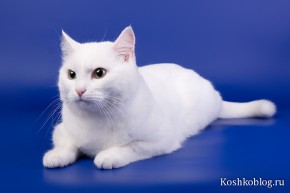
If a white cat has spots of any color on the head (a painted "cap"), and the tail is colored in the same color, then such a combination with white is called van. In fact, the cat is genetically black, blue, red or other, depending on the color of the "cap" and tail, but its color is covered by a large white spot, leaving only small painted areas on the cat's body. A cat with a greater number of color spots, but no more than a third, closed by them, with sufficient spaces between the spots, carries a color called harlequin. A cat, painted approximately half, and half white - bicolor. And, finally, there are colors with residual white, with white spots, medallions, etc. - for example, a white patch on the breast, white paws - "slippers", small white spots on the abdomen.
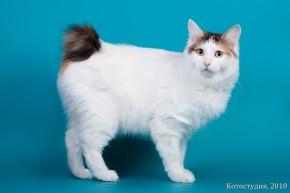
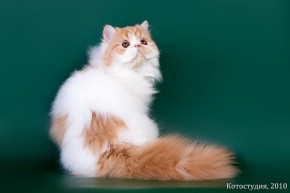
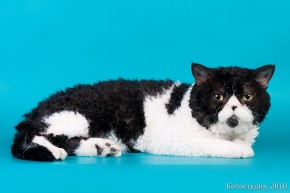
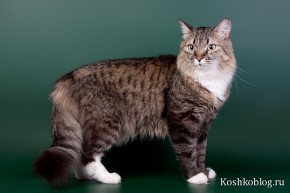
The combination with white can have a cat of any basic color. So, we have already learned that our cat is a van, a harlequin, a bicolor or with a residual white, or without a white one at all. And how to determine its main color? The main colors of cats, which can be found on the street, are not that diverse. We will not take into account neglected owners of pedigreed cats thrown out on the street. Targeted selection has shredded a large number of shades - chocolate, lilac and many others - but now we are interested in "natural", "natural" colors. it black, blue (gray) - a clarified version of black, red (red) and cream - Clarified red. These colors easily differ from each other both in the continuous version, and in combination with white. In cats, unlike cats, as already mentioned, black and red (or their clarified versions - blue and cream) can be combined in the color of one individual, this combination is called tortoiseshell color, or tortilla. A cat-turtle is painted either black with strands of red, if it is without white, or large spots of black, red (or blue and cream) and white flowers, and white is distributed according to the principle described above. That is, the cat can be white with a black-and-red cap and tail - it's a tortoiseshell. Also there are tortoiseshell harlequins and bicolors, and how black and red, and blue-cream.
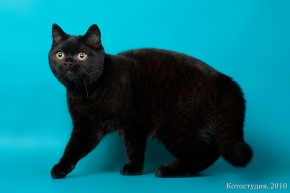
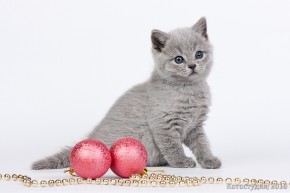
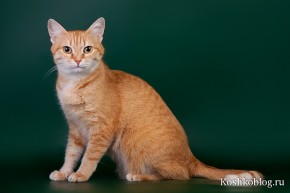
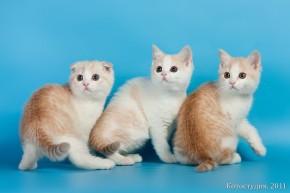
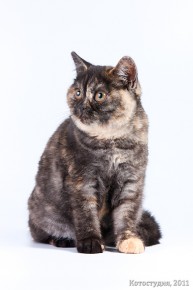
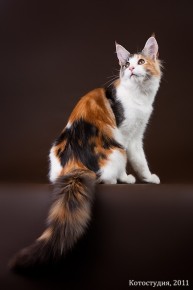
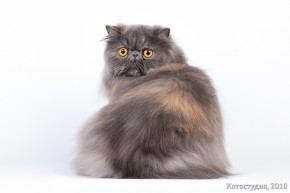
Still not like your cat or cat? Then we go further. Each of the described colors can be combined with a pattern (tabby). The drawing cat differs from the cat without a pattern with a dark eye stroke and the letter "M" on the forehead (this is the main distinguishing feature, it shows whether the cat is painted, even if it is very fluffy and the pattern on the back is blurred), and also the pattern on the back . Also the color of the mirror of the nose will be different. The tabby cat also has lighter wool on the neck and abdomen, as well as on the underside of the tail. For drawing in a cat there are several varieties of genes, respectively, a cat can be spotty, striped, marbled or ticked. Marble and ticking, we will not consider, since the carriage of these drawings is a privilege of mostly thoroughbred cats. Back spotted cat covered with spots, clearly separated from each other and contrasting with the main tone, tail and paws are colored by rings. Have tabby cat instead of spots - solid strips, this figure is also called a brindle. In cats, the color of which is not supported by selection (that is, our favorite Murzikov and Murok with us), the bands may not be continuous, but ripped, and then the color is something between the spot and the strip. Spots or streaks have the color of the main color of a cat - for example a cat with black spots - a black spotted, a cat with gray stripes - a blue brindle. The overall tone of the coat of such a cat is much lighter, for example a black spotted cat - a brownish-brown shade with black spots. This tone and confuses many in determining the color - for example, the owner of a black tabby cat may think that it is chocolate, but in fact it is just a warm shade of "substrate" spots. It will not give a mistake here the color of the pads of the paws and the mirror of the nose - black tabby cats have black paw pads and a mirror of the nose brick-red with a black stroke. Also many, knowing that tricolor cats do not happen (a widespread phrase, in fact there are no tortoiseshells, not just tricolor cats, and a cat can be two-color - black and red without white, but nevertheless the same two-colored cat can not be), claim that they have a "phenomenal "The tricolor cat - in fact it's just a black spotted with a white cat, whose warm tone of hair was adopted for the third color. Tubby can manifest itself on tortoiseshell cats, painting them even more bizarrely. That is, for example, the same black-red-white (or without white) cat, being also hand-drawn, has the letter "M" on its forehead, and spots or streaks on its back. Even on the color of a tortoise-shell, the tabby marks will be visible - this is the same letter "M" if the forehead is painted quite strongly (or its upper "tails", if the colored part only comes down a little on the forehead. torby (from tortie tabby). Cats of red and cream color always tabby (among the thoroughbreds, red and cream animals are selected without a pattern, but there are simply no such mongrel). Therefore, there will always be a drawing on the red, cream and even untouched tortoiseshell, or rather on its red or cream part, (so a tabby or untethered turtle can be determined only by its black (blue) wool - the tabby tortoiseshell has strips or spots on it all wool, besides, she will have the letter "M" on her forehead).
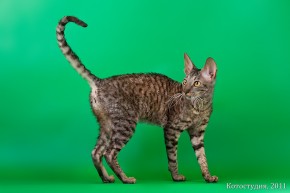
![]()
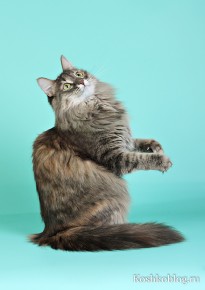
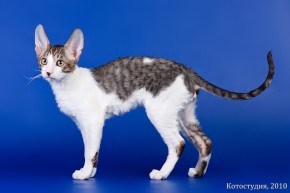
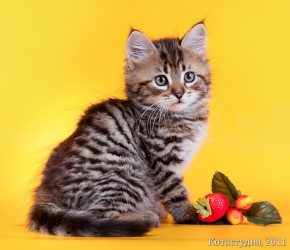
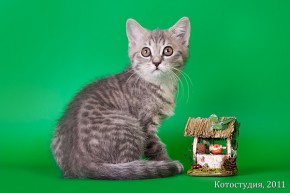
Uncut and drawn cats can also carry in their color smoke and silver. This is manifested in the color of the roots of the hairs - they are white, and when the hair of such a cat is raised, it is very beautifully poured. This is seen, for example, when the cat is moving. Drawing cats can be silvery, their main tone is much paler than that of tabby cats without silver, it is almost white. The figure on this background is more contrasted. Stains or strips on silver can be any of the primary colors - black, blue, red, cream (again, this is not a complete list, but we do not consider breeding colors). Smoke in a cat of solid color can also be combined with any color - black or blue, red or cream smoke. On the basis of smoky colors, animals were hatched, the hairs of their hair painted only on the tip (one quarter or one eighth). it shaded and chinchilla cats - Animals of fairy beauty. But they do not run along the street (ideally cats should not run around the streets at all, they are still domestic animals), so let's return to what we have.
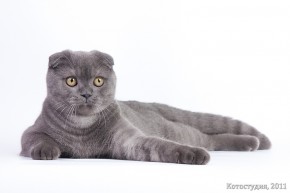
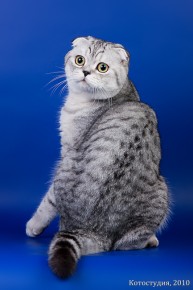
If among all this you have not found anything like the color of your animal, and the eyes of your beast are bright blue or saturated blue, then your cat or cat is the color color-point. This same color is called acromelanic or siamese (since the first breed in which this color has spread is the Siamese breed of cats). The color-point dark marks on the muzzle, ears, paws and tail, and the main tone of the body is much lighter. Markings can be either black or blue, or red or cream. Or tortoiseshells (red-black and blue-cream) in cats. Such colors will be called force-point (black marks), blu-point (blue marks), red point (red marks), cream point (cream marks); force-tortie point (black and red marks), blu-cake point (blue-cream marks). Eyes with any color marks have a blue color. Perhaps a combination of this color with white - for example, a cat with a dark muzzle, ears and tail and with white paws, as if shod in slippers, as well as with a drawing - though on the light back the pattern will not be visible, but the letter "M" on the forehead cats can be accurately read. Color-points with a pattern are called link-points, eg force-link-point (black color-point with tabby-marks). Cats of acromelanic color - incredibly beautiful creatures, both in continuous variation, and in combination with white. In our country, such cats are very popular, even mongrel cats of this color are called "Siamese" and are bred for profit since Soviet times. Commercial mass reproduction served them badly. When there were very few of them, just a few, everything that had dark marks and blue eyes multiplied, regardless of the character. And after all, it is transmitted genetically, and many animals of this color inherited a bad character. Many of the cats with the character were on the street, creating populations of animals of Siamese color and its carriers. And despite the gaining thoroughbred breeding of Siamese cats, as well as cats of other breeds of this color, having a wonderful temperament, the people found in themselves an ineradicable belief that Siamese cats are evil and aggressive. And who knows how many years will pass before people stop thinking like that.
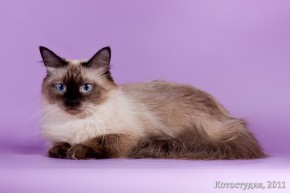
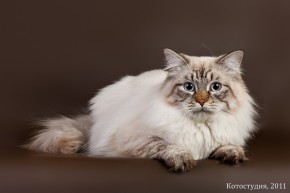
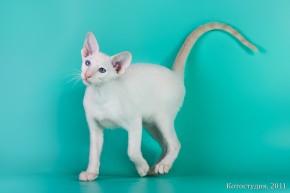
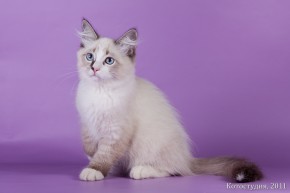
Well, all the basic options are reviewed, so if your cat does not fit any of them, then she probably had a thoroughbred ancestors, and she got something in her color. However, do not rush to think so, calculate all possible options - perhaps you have read something inattentively, or the color is expressed implicitly due to too long hair (or poorly maintained wool in poor condition).
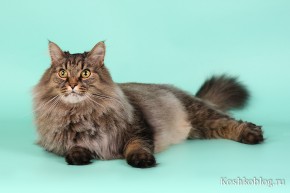
The cat's color is exactly a tabby (the letter M on the forehead is distinguishable), but the pattern is not determined, since the wool is too long and already gray from the venerable age
In the correct name of the color, the first is the main tone, then the type of drawing and then the combination with white. Next comes the color of the eyes, if it is some unusual for this color. Ordinary eye color is not prescribed. For example, the color of a black and white cat with an approximately equal amount of black and white will be called black bicolor
When the breed of Scottish Fold cats only gained popularity, the main colors of the wool cover were, as a rule, lilac, gray, cream. Such a meager assortment was explained by the lack of a breeding base and crossing with representatives of the British breed.
Today scottish Folds have many colors. Such a wealth of color palette inherited them from the closest relatives - short-haired Britons. The wool of Scottish folds can be monophonic, which, however, happens rarely, more often a combination of different shades is observed on their woolen cover. Very popular colors with the presence of white.
Work with them began not so long ago, therefore they are considered a rarity. Breeders assure that animals with such colors will soon occupy high positions in the rating of popularity of folded cats.
It is proved that the color of the fur coat is affected by certain genes. Red and black colors are considered folding for the fold, but the recessive gene can be suppressed dominant. Intensity level also corresponds to a certain gene diluting the main color and turning, for example, chocolate into purple.
According to the existing standard of the breed, all colors of Scottish folds are allowed to participate in exhibitions, without exception, there are more than 60. Folds usually have copper, orange eyes, but in some types of color, green, golden, and blue can be observed.
Solid (solid)
This type of color implies a single rich shade of fur without ticking and patterning. Clear spots, wool of a different shade is not allowed, which when cream or red color is difficult to achieve. Such cats can be observed, but weak patterns on the tail, muzzle, paws, and less often on the trunk are undesirable.
Solid colors occur intense (black, red, chocolate) and diluted (marble, lilac, cream).
Scottish Fold, color black (ebony)
The color is predominantly bright. Red, brown areas of wool cover indicate a defect. Representatives of this color, in ancient times considered mystical, among the folds are not so rare.
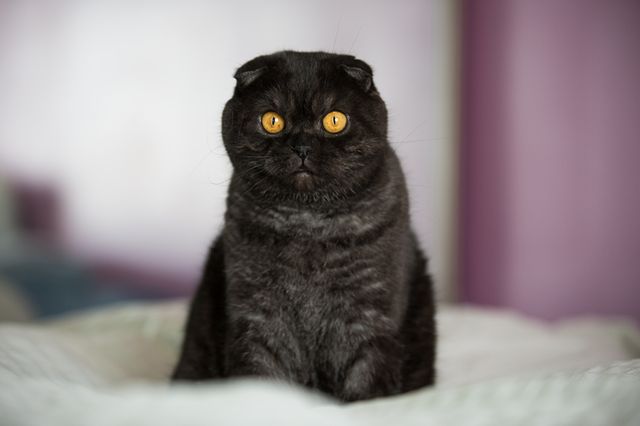
Scottish Fold, color chocolate
For this beautiful coloring, the undercoat of some other color, light wool, various patterns are not characteristic.
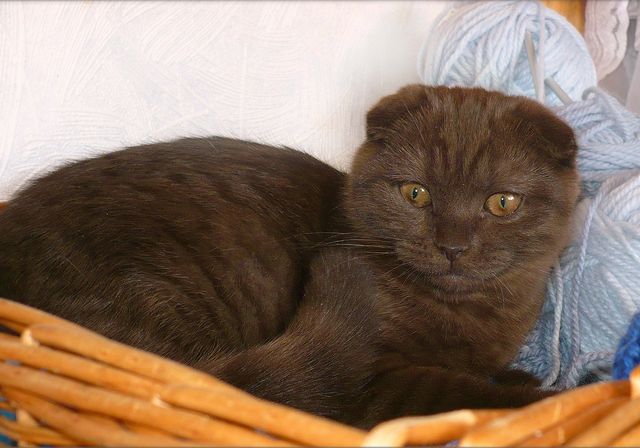
White
Snow white with glitter, yellowness absent. Newborn babies are allowed to stain on the head of a bluish hue, if there were ancestors of the blue coloring in the family, or dark - if someone from the progenitors was black. In an adult, the fur becomes perfectly white.
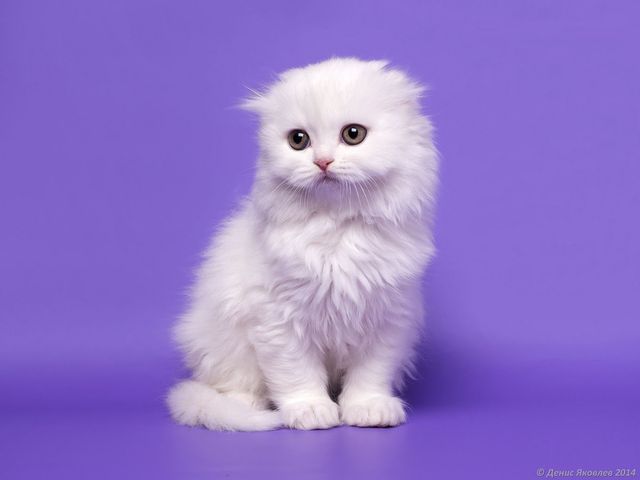
Cincinnamon
A rare warm color, looks no less spectacular than a rich chocolate.
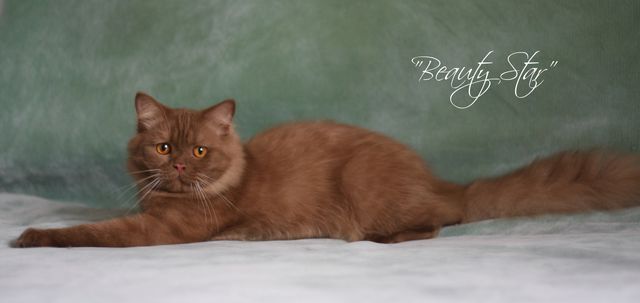
Scottish Fold, color lilac (lavender)
Coffee with milk - that's how this delicate, delicate shade of wool is characterized.
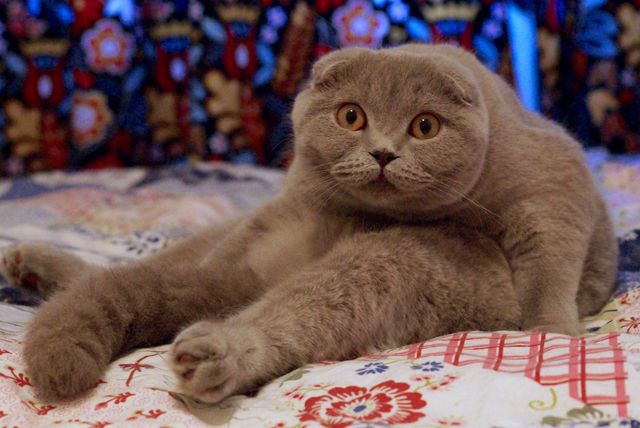
Deer (fawn)
Kittens, whose fur is painted in a touching soft beige shade (clarified cinnamon), look touching and cute.
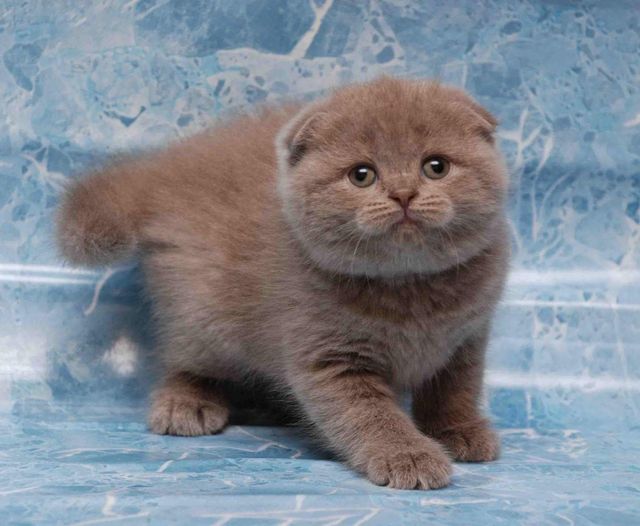
Red
Rare color, implying an intense continuous shade, evenly pigmented and distributed throughout the body. On the forehead and extremities is acceptable, but undesirable pattern is undesirable. The light (red) tip of the tail is a defect of the rock.
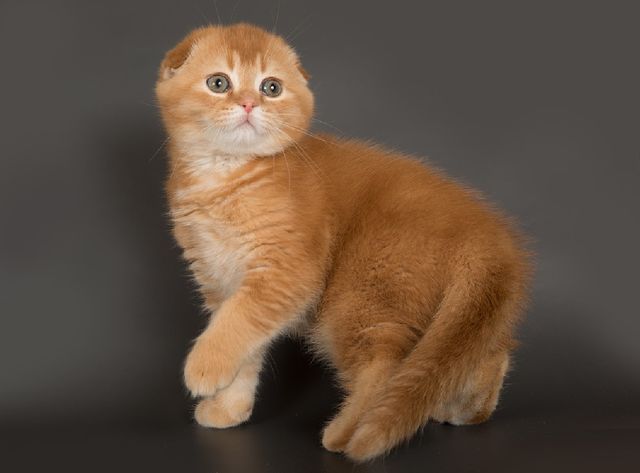
Blue color (blue)
Classical coloring, allowing the entire color palette of blue: both light and dark colors. The baby can have moiré patterns, which then disappear.
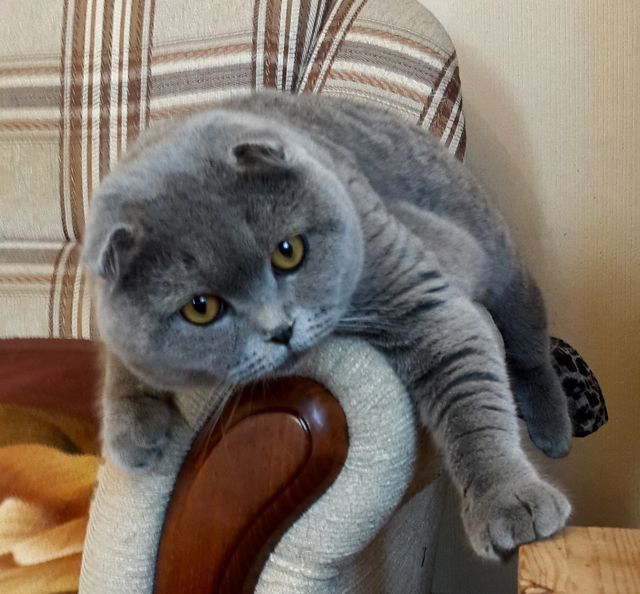
Cream
Diluted red with the addition of a gentle peach tone. On the forehead and legs, a fuzzy pattern is acceptable, but a noticeable leopard park is unacceptable.
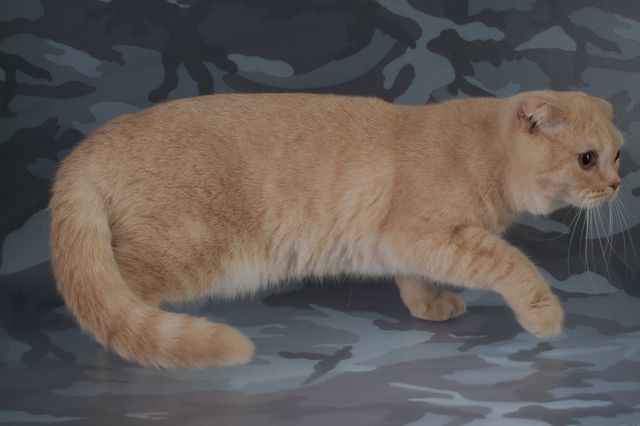
Bicolors
The color of the fur coat, in which a significant area of wool cover is snow-white. Be sure to have white belly, chest, neck, chin, limbs, face. Other shades are distributed evenly, without predominance in any area. The muzzle, like a royal sign, is decorated with a speck in the form of an inverted Latin "V".
If the neck has an unclosed "collar" of white color, the value of the animal is increased.
The combination of snow-white is allowed with any of the available colors.
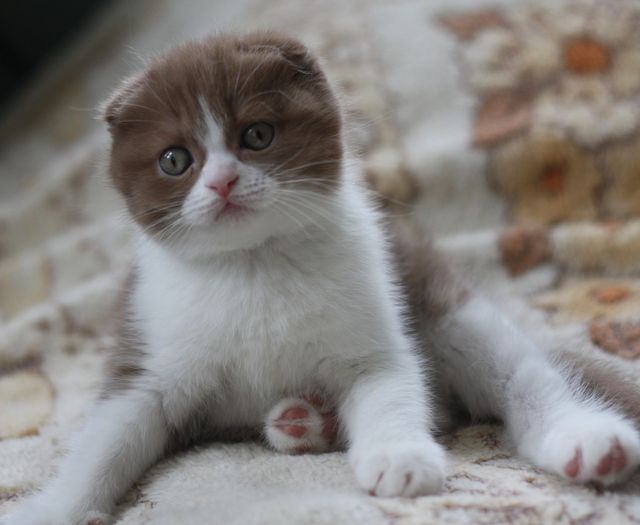
Particolor (calico)
Coloring is a combination of classic white and tortoiseshell color.
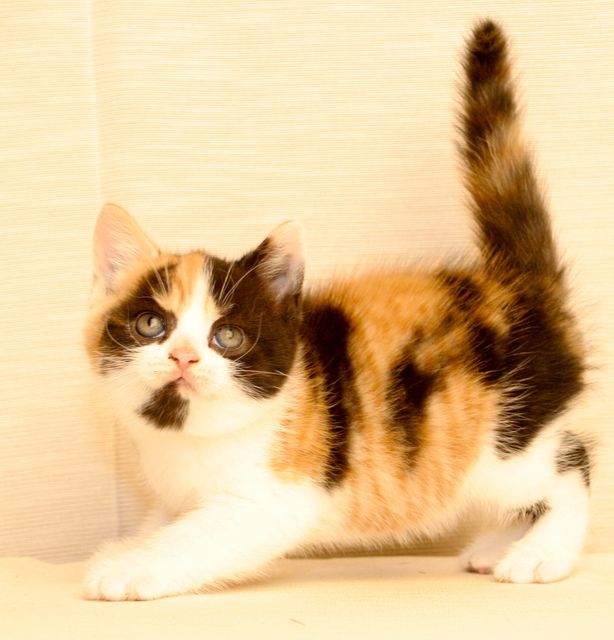
Harlequin
Unusual color literally conquered the breeders. With such a non-standard coloring, more than 1/5 of the body is white, the spots are unevenly located on the muzzle, spine, flanks, symmetry is desirable. The tail is necessarily dark.
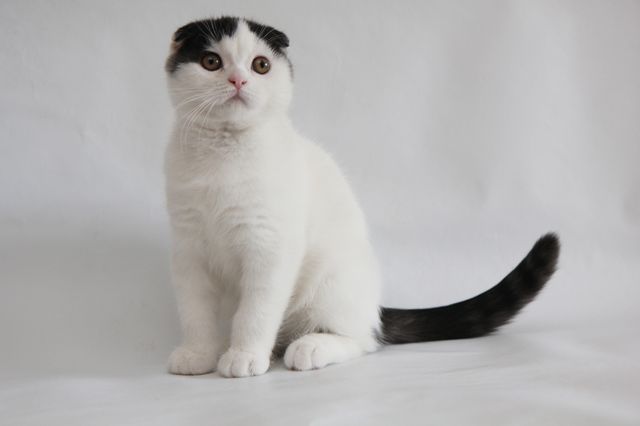
Wang
The cat or cat is almost completely white, only a few sections of the coat can be colored - on the head and tail. Allowed, but unwanted spots on the body and paws. If the specks are red, then the cat is called a red wine.
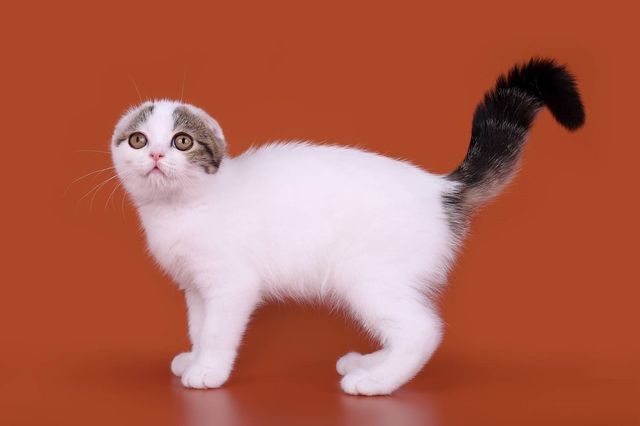
Color Pontus
In Scottish Fold cats this kind of color is considered rare. Elite coloring folds due to their British ancestors, who in the family were Persians with a similar color. The body of the cat is light, and all the protruding parts (ears, muzzle, tail, paws) are painted in brighter colors, forming an effective contrast with the basic shade of color.
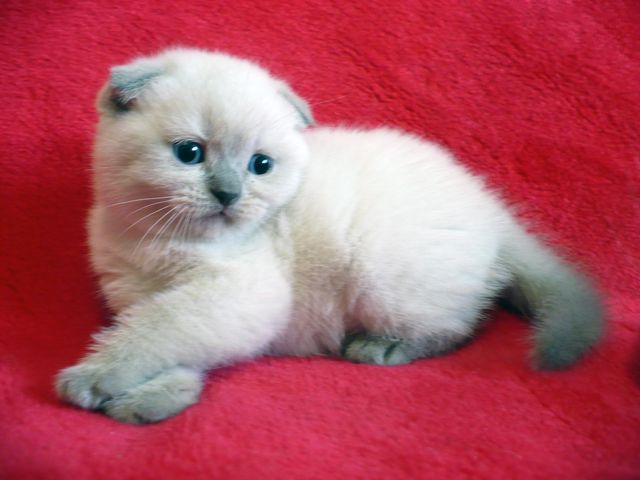
Tabby (tabby)
For today it is the most popular color. He assumes a certain pattern and zone-colored hairs. Can be presented in two versions - classic and marble.
Characteristics tabby color:
- bright spots on the back of the ears;
- "M" on the frontal zone;
- the eyes and nose have a basic hair color;
- "Necklace" in the chest area;
- closed rings on the limbs and tail.
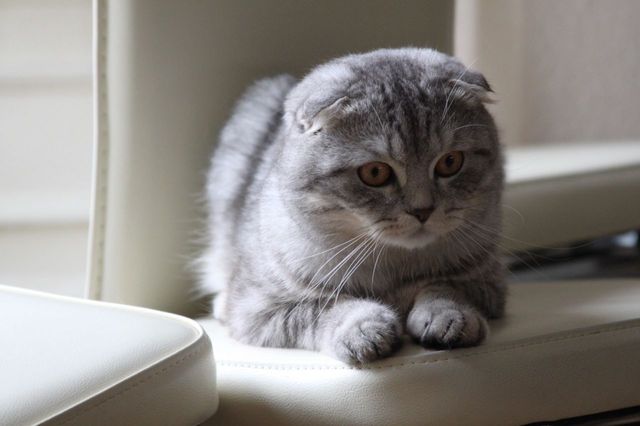
The more clearly the pattern on the fur coat, the more valuable the cat, the more points will be given to the pet at the exhibition.
Colors tabby, depending on the type of pattern, can be of the following types:
- mackerel (tiger) - vertical, contrasting stripes along the sides, a dark strip along the spine and tail;
- spotted (spotted) - contrasting spots of round or oval shape on the sides of the body and a vertical torn strip on the back;
- shaded (marble) - ornament in the form of a butterfly on the shoulders, three stripes on the back, specks on the abdomen, circles and divorces of a symmetrical shape.
- black marble (marble on silver) - the most spectacular, luxurious color.
Colors tabby, depending on the color combinations, can be as follows:
- silver - silver, black clear pattern;
- silver-blue - an undercoat of white color, a slightly red-colored mantle at the sides, tail and muzzle.
- red - light red, clearly expressed red pattern;
- brown - copper, black figure;
- blue - cream-blue, blue pattern;
- cream - pale cream, a pattern of the same color, but brighter;
- cameo tabby - white, red stripes.
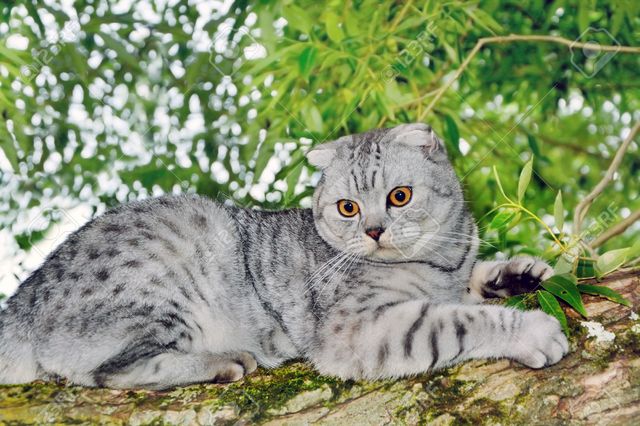
The standard does not allow the presence of a gray undercoat, as well as white spots on the limbs, chest, groin. White chin is considered undesirable.
Scottish Fold tortoiseshell colors
It is an original combination of red and dark or cream stains. Do not be confused with the tricolor coloring, since the cream shade in the tabby pattern is a clarified red. There is no well-defined standard for tortoiseshell color, the only condition - the distribution of colors should be harmonious.
It is noteworthy that only cats are the owners of a rare tortoiseshell color. In cats it is observed only in cases of genetic failures, to reproduction of offspring such individuals are incapable.
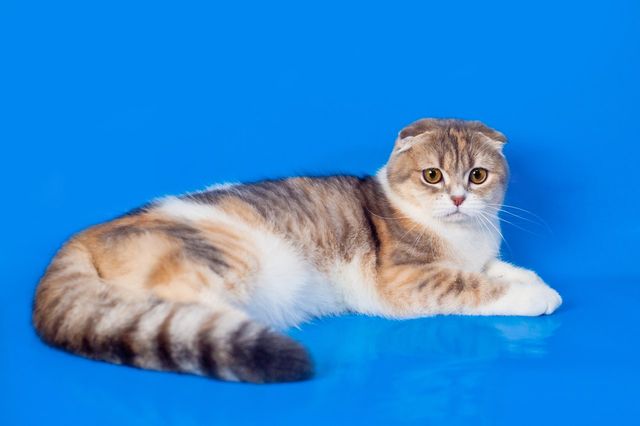
Shaded
Currently enjoys great popularity among breeders. With this type of color, 1/3 of the tip of the hair is colored, the rest is white. Also, it is characterized by lightened hair tips, light undercoat, shaded hair in the back, tail, head, ears, light chin, belly and bottom of the tail, the main color tipping.
Among the shaded colors are:
- Golden - cream undercoat, woolen fur coats have black tips.
- Silvery - the undercoat is white, the ends of the main coat are gray and black.
- Red - a white undercoat, the basic wool of bright red color, red "hatching" on the sides, bottom of the tail, stomach, muzzle and chin of a lighter shade.
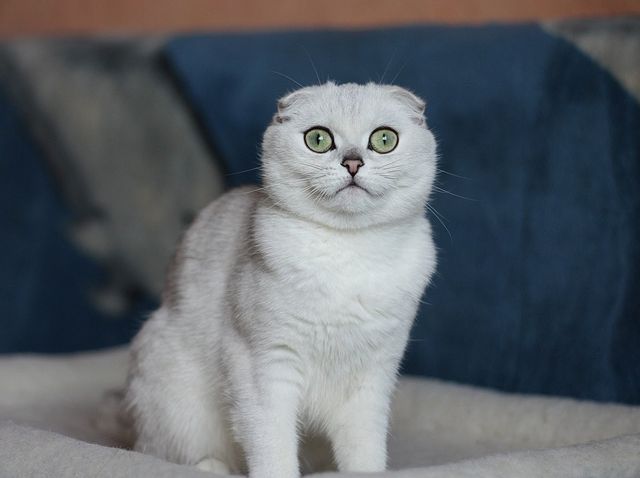
Chinchillas
Such an expressive and beautiful coloring Scots are obliged to the British, and they, in turn, borrowed it from exots and Persians. This rare coloring is found only if the mother and daddy of the kitten are chinchillas. It is characterized by the coloration in one tone of 1/8 of the area of the wool, other areas of wool cover in white.
Classification:
- Silver chinchilla. A peculiar combination of light undercoat and "hatching" black. Snow-white ears, tummy.
- Gold. The separate zones of the hull are "shaded" intensively fiery red. Tipping paws, muzzle.
- Golden (blue). The rarest coloring is formed by the undercoat "melted milk" and bluish tipping with a shimmering radiance.
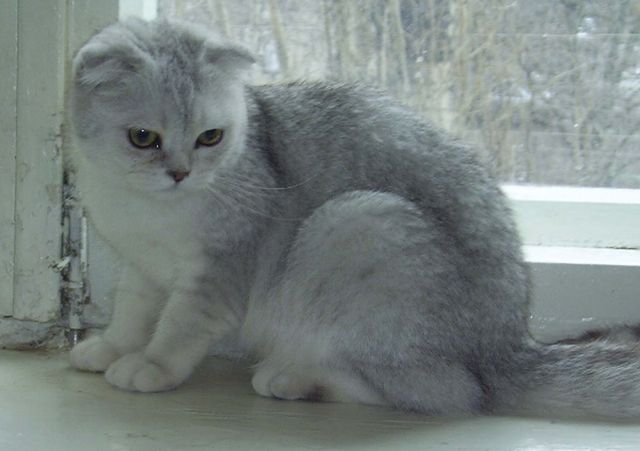
Smoky
This coloring appears under the influence of a silvery gene and is inherent in folds, in which the coarse hair hairs of solid color - black (black smoke), red, purple, blue. The undercoat base has a silvery white color. Due to the contrast of the shades, it seems that the cat's coat has the color of a light misty haze.
It should be noted that smoky color is considered to be undervalued today, animals with such wool color are not allowed to participate in exhibitions. But breeders believe that smoky cats are among the most attractive folds.
![]()
Do you like cats and want to have a pet playful pet? Then the Asian tabby is perfect for you. This multi-colored beauty with a short soft coat is an ideal pet for a loving family!
History of the breed
Asian tabby appeared in the 80 years of the 19th century, the breed was bred by crossing the Burmese and Persian chinchilla. And in England it was recognized in 1990. The constitution of the cat is similar to Burmese, but it has a different color.
On the forehead of the cat there are characteristic marks - the "scarab sign", which also adorns the wild marble or spotted representatives of the cat.
Features of the breed and the external characteristics of cats
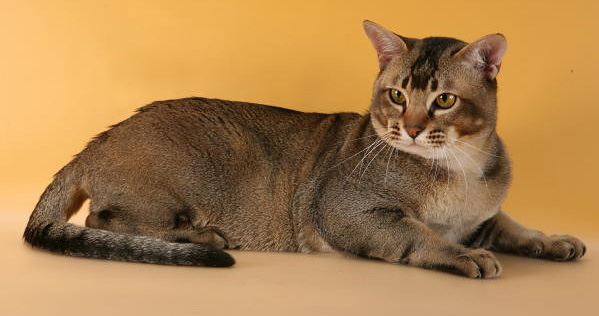
A photo. Asian Tabby
A tabby strong well-built body, they are medium in size and have a weight of about 4-7 kilograms. Cats have almond-shaped slightly slanting eyes with an iris of a golden hue, rounded ears are dark inside and tapering towards the end with a ring with piercing rings.
Cats like a necklace on the neck, and a stroke around the nose, mouth and eyes, short hair.
Asian Tubby breed standard:
- the body is sturdy with a broad chest and straight back, shoulders and hips are equal in width;
- tapering at the end of the tail;
- the head is rounded in the form of a blunt wedge;
- thin delicate oval legs, strong and muscular enough;
- large, widely placed rounded ears with a slight inclination forward;
- short shiny coat without undercoat;
- eyes almond-shaped, widely set, from yellow to amber;
- green eyes, sunken cheeks are white spots.
Varieties in color and photos of cats
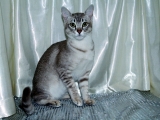
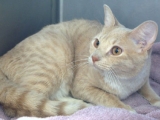
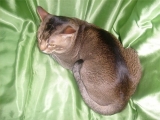
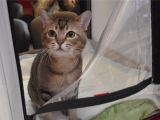
There are the following types of cats in color:
- spotted - spots of different shape and size are located throughout the body;
- marble or Shade - side tabby decorated with a pattern similar to marble stains;
- tiger or mackerel - vertical parallel strips along the body;
- tikkirovanny or Agouti - a picture on the face and zoned color of each hair, called agouti throughout the body. This kind of color has no spots or stripes.
The color palette is very wide in colors, from pale blue to saturated red. Usually it is cream, chocolate, apricot or reddish-red.
Character, intelligence and learnability
Tabby is very open and friendly cats, lead an active lifestyle, love to play. They are quite curious and inquisitive. Easily get along with other pets, do not offend young children and is very calmly alone, are flexible and soft. Cats are playful and mischievous, but they like to sit on the hands of the owner. They need to receive attention and feel the love of the master.
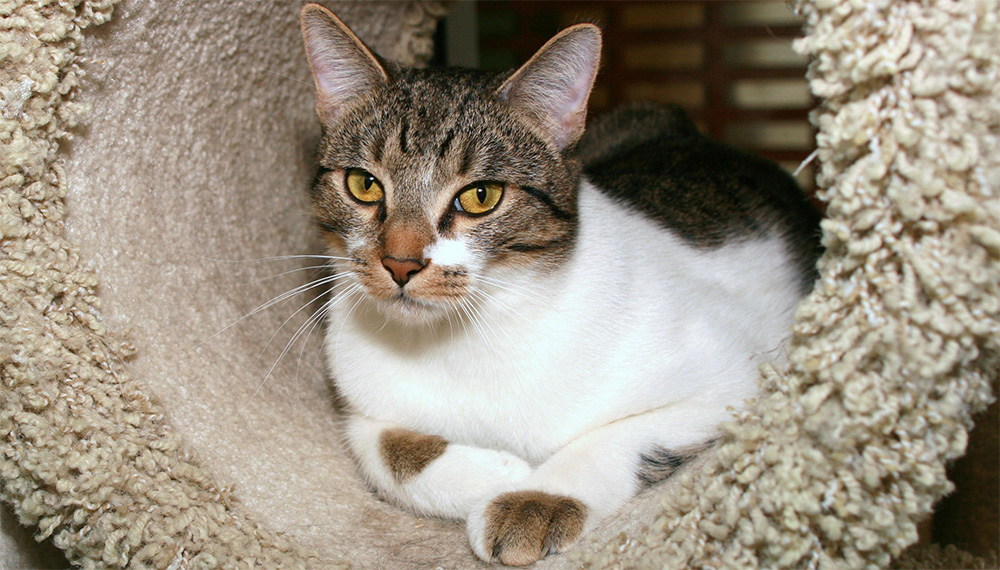
They quickly get used to the new conditions, and are distinguished by ingenuity. Very curious and attentive animals. They do not spoil the furniture and are very amenable to training.
Tabbi quickly develop and grow, easily learn and are interested in the world around them.
Health of this breed
Cats of Asian Tabby breed have excellent health. With proper care and will feel great and live from 15 to 20 years. They have excellent immunity, which makes them extremely ill.
Make sure that the cat always has fresh water, and maintain order in the apartment.
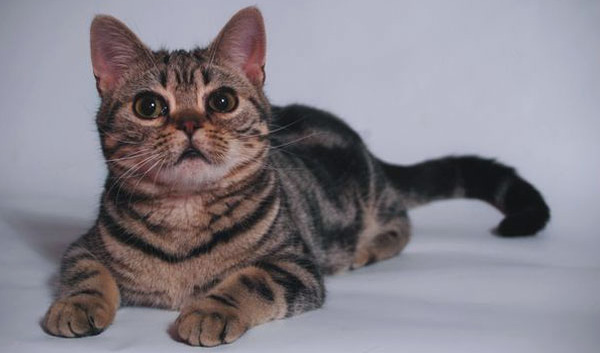
Asian tabby is very easy to care for
Cats of this breed are unpretentious and easy to care for. Periodically and occasionally, in the form of hygienic procedures, take care of the eyes and nose,.
To eat a tabby is not choosy, eat almost everything:
- Cats love fresh vegetables and fruits, meat and fish.
- The diet of the tabby should be balanced, contain vitamins and trace elements.
- Proteins and fats for the harmonious development of cats are found in meat and fish, eggs and dairy products. Carbohydrates are in cereals, they are added in smaller quantities.
- Feed dry cats of this breed is not recommended, but if you decide to buy ready-made food, then take brands of famous manufacturers, do not save on the health of your cat.
Price of the kitten and where you can buy

There are no nurseries of this breed in Russia
Unfortunately, in our country at present it is very difficult to buy a kitten of this breed, basically they are brought from foreign nurseries. Currently, the cost of a kitten is from 20 thousand rubles, and can reach up to 500 euros in foreign nurseries.
To get kittens with all necessary documents it is possible inspecial nurseries:
- Kennel «Golden Claw» Moscow E-MAIL [email protected]
- Nursery of Kramatorsk http://nellichkanovikova.umi.ru/
What to look for when buying a kitten of the Asian tabby
When buying a kitten should have the following documents:
- pedigree;
- metrics;
- green card (nursery from America).
At the first inspection of the kitten, pay attention to the eyes, they should not fester, the gums should be pink, without smell from the mouth and sulfur in the auricles.
If you want to have a four-legged friend, but due to life circumstances, often absent at home, the ideal option for you will be an Asian tabby cat. In ancient times tabby cats were made only by rich people. The cost of such a cat in our time is very high.
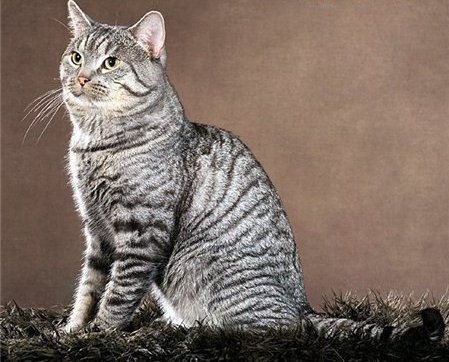
Breed Standards
This breed has a beautiful appearance and good character. The breed appeared in the UK, in 1990 as a result of a series of crosses. These are short-haired cats of solid build, medium size.
- Head. The head of the cat is of medium size, round in shape. Muzzle wide and short. The cheeks are bulky, round. Males differ from females with flabby cheeks.
- Ears. The Asian tabby ears are wide and round at the tips. Standing.
- Eyes. Wide-set, have a crescent section. The color of the eyes varies in shades of green.
- Extremities. Paws are wide, strong. Hind legs slightly longer than front.
- Wool. Tabby is a short-haired cat, with a fine texture, gloss and silkiness of the coat. The coat on the stomach is slightly lighter.
![]()
Color tabby
At Asian tabby cats are made 4 types of drawing on wool:
- marble;
- brindle;
- spotted;
- ticked.
Colors vary: gray-blue tabby cat , , chocolate, apricot, brown, caramel, cream and lilac cat.
The characteristic features of the color of this breed are:
- "Necklace" on the neck;
- eye, nose, and mouth;
- dark marks on the forehead "a sign of a scarab".
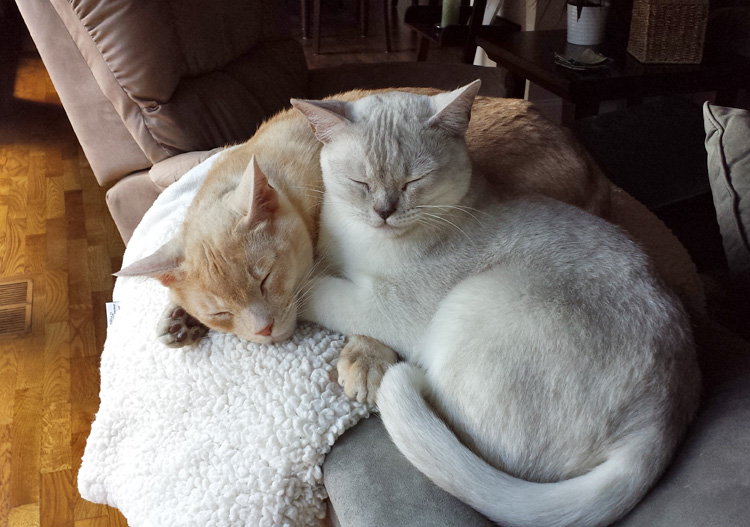
See how beautiful cute and fluffy seals have settled on a soft pillow. Well, just emotion. Order and yourself the same soft pads for rest. Present yourself a bit of bliss just like the tabby cats. After all, such noble cats will not sleep on anything.
Character
Tabby has the character inherent in all Asian cats: she is graceful, intelligent, noble, her appearance is elegant, and she understands her master.
Such cats at a small age are very active and playful. They happily contact the children, take pleasure in the petting of the owner and reciprocate.
Tabbi is very attached to the owner and the house, so in case of departure, try not to give the cat to another apartment. They tolerate loneliness better than a change of scenery and the presence of strangers. Tabby is very loyal. Once loving his master, they once and for all become attached to him.

Care for Tabby
These cats are unpretentious in care. They have a natural nobility, they are able to watch their own species on their own. Since the tabby is a short-haired cat, it will not require special care for the hair. Seasonal molts pass without any trouble for the owner. She needs a rare combing of wool and washing if necessary with the use of special cat shampoos. Cat cats need a rare haircut.
Easy care of the cat, carried out by a caring owner, will give your pet long health and good mood. And you - a pleasant admiration for the beautiful and well-groomed appearance of the animal. If you have a long-haired cat, read the article about
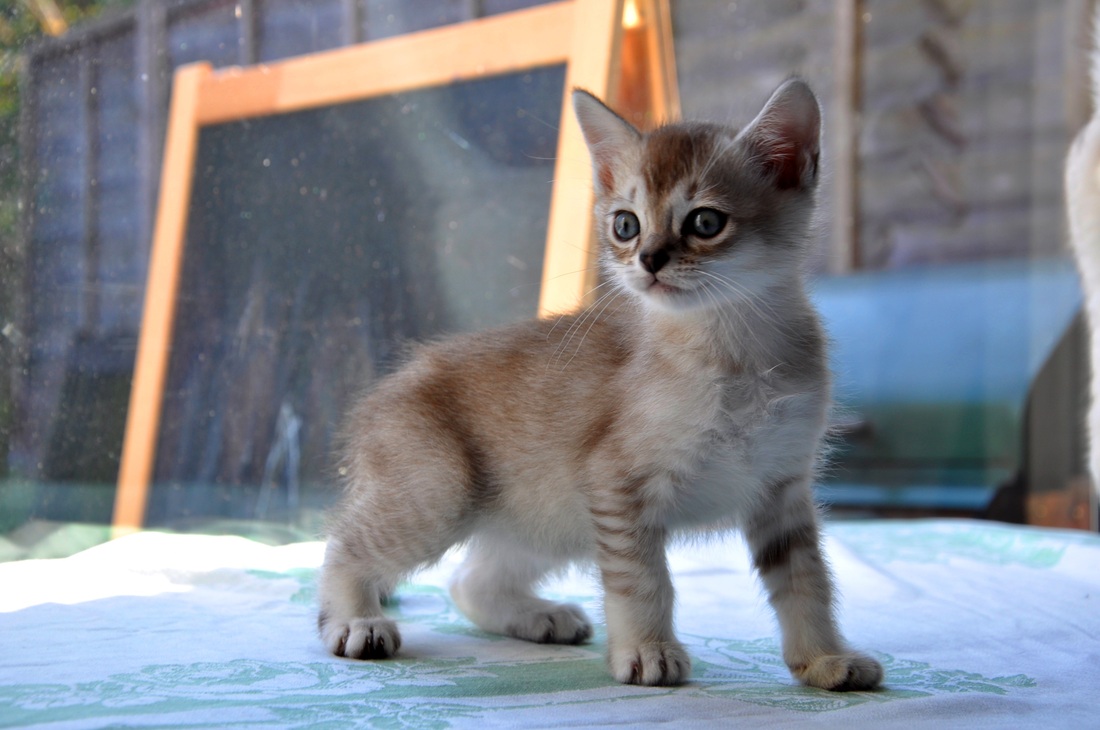
Cat Health
This breed does not have specific health problems. These are quite healthy cats that have strong immunity.
However, do not forget that even the most healthy cat at the genetic level, can lose its health in poor conditions of existence.
The owner of the pet should include in the diet of various, high-grade food, with the high maintenance of the useful substances necessary for growth and development of an animal's organism. The cat should always have clean fresh water. Keep an eye on the order in your apartment and do not let animal contact with dangerous substances.
With proper care and care for the pet,

